Free Professional Learning Resources for Teachers
Want a quick overview of how to flip a classroom? Or maybe a full, customizable professional learning session focused on differentiation? Whether you want to try a new strategy on your own or collaborate with your colleagues, these resources will keep you moving forward in your practice.
All Resources
Filters

How-Tos and Overviews
Better Feedback in the Social Science Classroom
Effective feedback has certain characteristics: it is specific, actionable and timely, focused on improvement, and encourages self-assessment with a growth mindset. But what do those characteristics look like in a social science classroom? This overview of effective feedback not only explains each characteristic, but also provides an example for each one that is rooted in the work and language of the social science classroom. Following the examples is an opportunity to take it a step farther and brainstorm specific ways you can reframe current feedback practices to be more effective. Wrap it up with a printable sign for your classroom to help you keep these core practices in mind.
Related Resources

How-Tos and Overviews
Better Feedback in the Science Classroom
Effective feedback has certain characteristics: it is specific, actionable and timely, focused on improvement, and encourages self-assessment with a growth mindset. But what do those characteristics look like in a science classroom? This overview of effective feedback not only explains each characteristic, but also provides an example for each one that is rooted in the work and language of the science classroom. Following the examples is an opportunity to take it a step farther and brainstorm specific ways you can reframe current feedback practices to be more effective. Wrap it up with a printable sign for your classroom to help you keep these core practices in mind.
Related Resources

How-Tos and Overviews
Better Feedback in the English Classroom
Effective feedback has certain characteristics: it is specific, actionable and timely, focused on improvement, and encourages self-assessment with a growth mindset. But what do those characteristics look like in an English classroom? This overview of effective feedback not only explains each characteristic, but also provides an example for each one that is rooted in the work and language of the English classroom. Following the examples is an opportunity to take it a step farther and brainstorm specific ways you can reframe current feedback practices to be more effective. Wrap it up with a printable sign for your classroom to help you keep these core practices in mind.
Related Resources

How-Tos and Overviews
Better Feedback in the Math Classroom
Effective feedback has certain characteristics: it is specific, actionable and timely, focused on improvement, and encourages self-assessment with a growth mindset. But what do those characteristics look like in a math classroom? This overview of effective feedback not only explains each characteristic, but also provides an example for each one that is rooted in the work and language of the math classroom. Following the examples is an opportunity to take it a step farther and brainstorm specific ways you can reframe current feedback practices to be more effective. Wrap it up with a printable sign for your classroom to help you keep these core practices in mind.
Related Resources

Templates and Examples
Project Planners for Student Collaboration
In order for group work to be effective, students need to build and practice crucial skills: collaboration and planning. Customize these student-facing planning materials and help students set project milestones, use class time effectively, and understand expectations for work outside the classroom.
Related Resources

How-Tos and Overviews
Teacher Leader Observation and Reflection Framework
Pairing teacher self-reflection with classroom observation and coaching by a mentor, peer, or other teacher leader can be a powerful way to drive professional growth. Customize this framework so that the process of observation and reflection is collaborative, formative, and personalized according to the needs of the teacher, the students, and the unique context of the lesson.
Related Resources

Templates and Examples
Hexagonal Thinking Activity
Hexagonal thinking is a versatile strategy that combines discussion and debate, critical thinking, and problem-solving. Just as no two students are alike, no two hexagonal webs will look alike. Review the example hexagonal thinking activity and then customize the template with an activity for your class.
Related Resources

How-Tos and Overviews
Teacher Reflection Framework: Engagement through Effective Feedback
Learning and growing as a teacher requires reflection. It should be a dynamic and iterative process that helps you develop your practice and adapt to changing contexts and student needs over time. Customize this framework to reflect on how you engage students through effective feedback and the feedback cycle. The framework includes concrete examples of strategies and activities to help you plan for improvement.
Related Resources

How-Tos and Overviews
Teacher Reflection Framework: Engagement through Active Learning
Learning and growing as a teacher requires reflection. It should be a dynamic and iterative process that helps you develop your practice and adapt to changing contexts and student needs over time. Customize this framework to reflect on how your instructional practice engages students through active learning. The framework includes concrete examples of strategies and activities to help you plan for improvement.
Related Resources
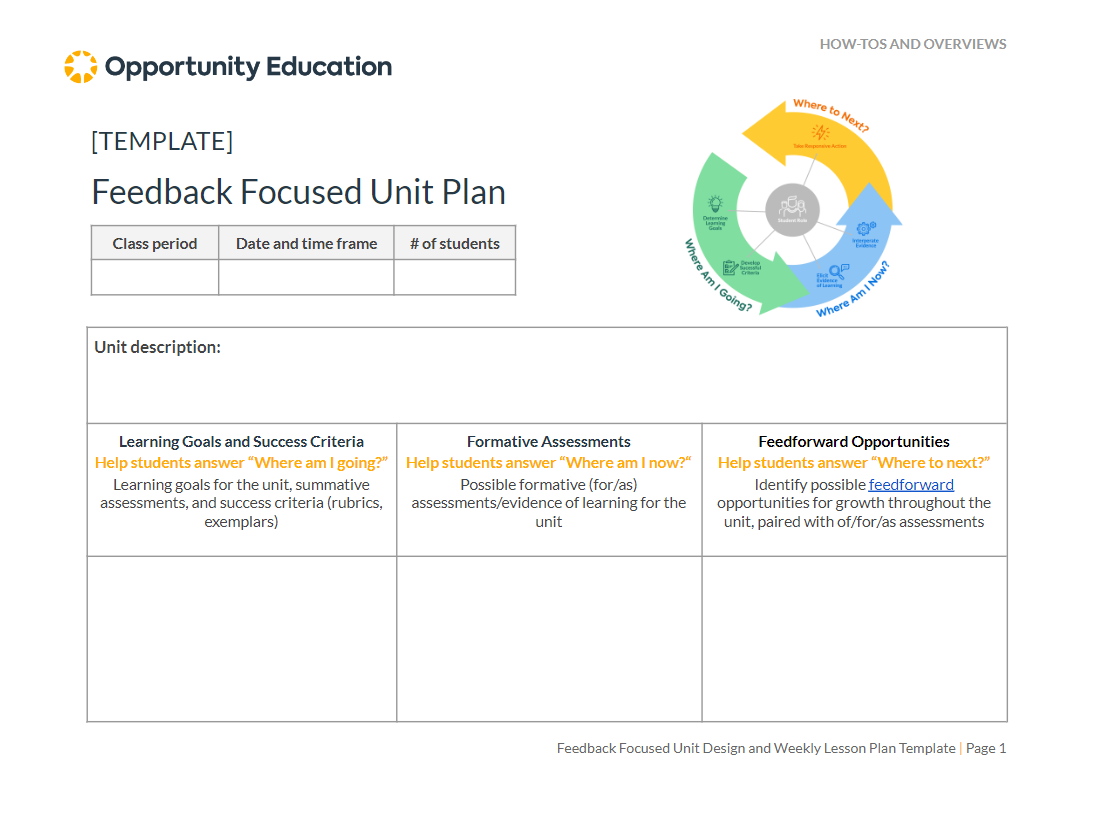
How-Tos and Overviews
Feedback Focused Unit Plan
Use this template to plan a unit focused on feedback opportunities. Plan for assessment for/as learning (evidence of learning) and assessment of learning while incorporating opportunities to involve students in the feedback cycle. Build in feedforward opportunities for growth throughout the unit so that feedback can drive drive student learning.
Related Resources

How-Tos and Overviews
Feedback Focused Daily Lesson Plan
Intentionally incorporate learning and skill goals, success criteria, and feedback opportunities in your classroom with this customizable lesson plan template. Plan for effective feedback so you can set up feedback cycles that drive student growth.
Related Resources

Templates and Examples
QPR: Active Reading for Student Engagement
When good readers read, they ask questions, make predictions, and reflect. They do this without prompting; this is active reading. This resource provides a template and example for the QPR strategy, which scaffolds the process of active reading, making it habitual for students. It asks students to question, predict, and reflect while they read (QPR).
Related Resources

How-Tos and Overviews
4 Ways to Use AI for Student Choice
Download this infographic to get started with strategies, prompt templates, and prompt examples to use AI to support student choice.
Related Resources
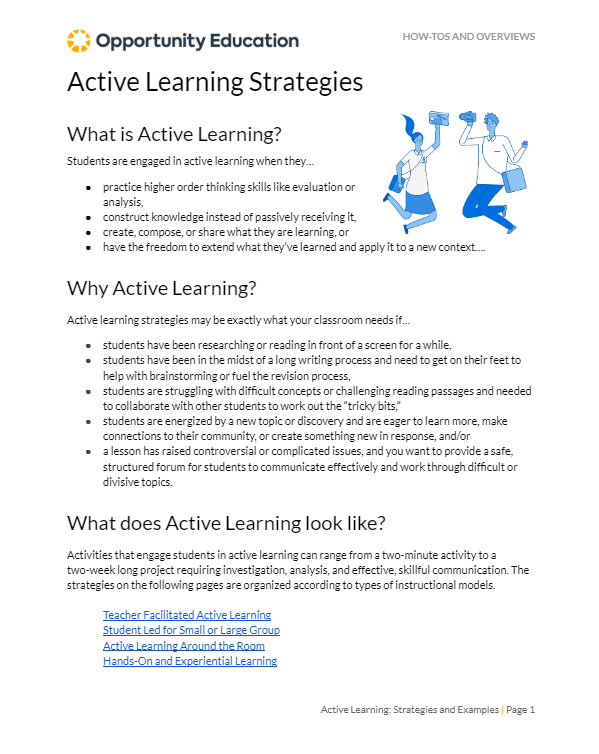
How-Tos and Overviews
Active Learning Strategies
Active learning has become the most often used yet most misunderstood phrase in education. So, what is it? It means that students are fully engaging in their learning, not dancing around the edges of it. This resource includes a comprehensive list of top active learning strategies, complete with examples and implementation options.
Related Resources

How-Tos and Overviews
Using AI To Support Student Choice
Supporting student choice can be overwhelming. How do you find similar articles with different reading levels? Or articles with similar reading levels but on different topics within a general subject? What about multiple options for final work products and directions for completing each project? Download this resource to get started with strategies, prompt templates, and prompt examples to use AI to support student choice.
Related Resources

How-Tos and Overviews
Co-Create Success Criteria with Students
If a soccer field was missing the goal, it would be pretty obvious to the players and coaches. But when it comes to assignments and projects, recognizing the goal (or recognizing that there isn't a clear goal) isn't always so easy. Download this resource to start implementing strategies for co-creating success criteria with students. Doing so will allow you to establish successful feedback loops with students.
Related Resources

Templates and Examples
Engagement Frameworks
Engaged learners prepare, focus, contribute, and invest in their learning. Engaged students perform better across nearly all metrics, and leave school prepared for the challenges of college, career, and life in general. Students need feedback on their engagement, and they need to reflect on their engagement in order to take ownership of their learning. Customize one or more of our engagement frameworks to give students actionable feedback on their engagement.
Related Resources

Grab and Go Professional Learning
Essentials of Daily Lesson Planning
How much planning needs to be done to manage a classroom effectively and engage students? What does an effective lesson plan include? Find answers to these questions in this customizable professional learning session. Participants will walk away with ready to use lesson plans for the classroom.
Related Resources

Grab and Go Professional Learning
Diverse Learners with Diverse Needs
Diverse learners are present in every classroom, and engaging them effectively means that a teacher needs to understand the active learning and feedback strategies that both support and appropriately challenge them. Lead this session to help your colleagues understand foundational concepts and terminology related to diverse learners and implement plans, processes, and strategies to meet the needs of diverse learners.
Related Resources

Grab and Go Professional Learning
Teaching Adolescents
Building relationships is key to teaching teenagers. And before you can truly build relationships, you need to understand the teenage brain and reflect on your perceptions of teenagers. Customize this professional learning session to help your teachers build positive classroom communities in your school.
Related Resources

Grab and Go Lesson Plans
Ordinary to Extraordinary: A Card Game
Every day we perform hundreds of tasks without thinking. Our brains would explode if we had to think about which hand to eat with or how to greet a friend. In this card game, students become curious about familiar actions and expand their thinking. They reflect on how curiosity can enrich their lives inside and outside of school. They try old things in new ways. Review the "Ordinary to Extraordinary" facilitation guide and determine how to facilitate game play and provide feedback for students. Then, print and cut out the "Be Curious" cards for student use to play the game.
Related Resources

How-Tos and Overviews
Active Learning Daily Lesson Plan
Customize this lesson plan template and use the example lesson plan as inspiration to ensure you are including the essential elements of active learning that drive student engagement.
Related Resources

Grab and Go Professional Learning
Educator’s Resource Guide
Before a neurosurgeon ever steps foot in an operating room, they have to learn hundreds of terms and concepts specific to their field. Before a mechanic can diagnose and repair a problem, they need to know the difference between a timing belt and a timing chain and a hundred other car parts and functions. Before a teacher ever meets their students, they need to know...what? Facilitate this session for colleagues to understand and apply knowledge of teaching terminology in order to develop effective plans for the classroom.
Related Resources

How-Tos and Overviews
First Days of School Checklist
Whether you are a novice or veteran teacher, it's overwhelming to plan for the first days of school. Both you and your students are coming in with prior experiences that have shaped your perspectives on school. Set the stage for learning, growth, and student agency with our checklist that will enable you to establish your support system, classroom routines, relationships, and academic expectations.
Related Resources

Templates and Examples
Get to Know Your Students
This resource includes four customizable examples of back to school inventories to help you learn about your students and make a plan to foster and maintain relationships throughout the school year.
Related Resources

Grab and Go Lesson Plans
Four Corners Growth Mindset Evaluation
Help your students evaluate their mindsets while engaging with new knowledge, one another, and you in a round of Four Corners. Customize the templates for your students’ needs.
Related Resources

Grab and Go Lesson Plans
Growth Mindset Assessment and Reflection
This lesson plan introduces students to the concept of a growth mindset by asking them first to reflect on their own thinking patterns. After they reflect, students explore resources and work together to reframe fixed mindset thinking. Foster a growth mindset with this grab and go lesson plan, and equip your students to navigate challenges, embrace change, and welcome and utilize feedback.
Related Resources

Grab and Go Professional Learning
Creating a Culture of Growth
Your mindset about growth, including your own ability to grow, heavily influences your beliefs about your students’ potential for growth. And your beliefs about your students are inextricably tied to their perceptions of themselves. Customize this session to invite participants to reflect on their own mindsets, students' mindsets, and strategies for creating a culture of growth in the classroom.
Related Resources

Grab and Go Professional Learning
Students as Partners in the Feedback Cycle
Customize this professional development session to help your colleagues evaluate strategies that encourage students' active participation in the feedback cycle. Students benefit from feedback when they understand how to take ownership of their learning goals, self-assess the progress they are making, and identify the steps they need to take to move forward.
Related Resources

Grab and Go Professional Learning
Learning Goals and Success Criteria
Facilitate a session that engages your colleagues in a feedback cycle as they establish best practices for clarifying and sharing intentions, learning goals, and success criteria with students.
Related Resources

Grab and Go Professional Learning
Feedback Fundamentals
Feedback feeling ineffective? Lead this session for your colleagues to help them create effective feedback loops in the classroom. Customize the facilitation guide, Google slides, and thought catcher for the unique needs of your school.
Related Resources

Templates and Examples
Feedforward Strategies
Want to foster a culture of growth in your classroom? Want to provide specific, actionable feedback focused on students’ development? Use these two customizable templates to feedforward and provide students with opportunities for growth.
Related Resources

How-Tos and Overviews
Assessment Of, For, and As Learning
Did you know there are three different types of assessment? You read that right! Use this infographic to learn about assessments of, for, and as learning. All three types play an important part in creating feedback cycles in your classroom.
Related Resources

Templates and Examples
Windows and Mirrors
Reading literature and viewing other art and media helps students make sense of the world, build empathy, and demonstrate compassion. The Windows and Mirrors strategy helps students practice a crucial skill: making the text-to-self and text-to-world connections that are the foundation of relevant learning experiences.
Related Resources

How-Tos and Overviews
Get Started with Flexible Pacing!
Ditch the podium and set the stage for student agency with this infographic that covers the basics of flexible pacing. Flexibly paced personalized learning creates opportunities for multiple, differentiated paths for students to drive their own learning. Use this infographic and the links included for ideas, tools, and strategies to start creating paths for students today.
Related Resources
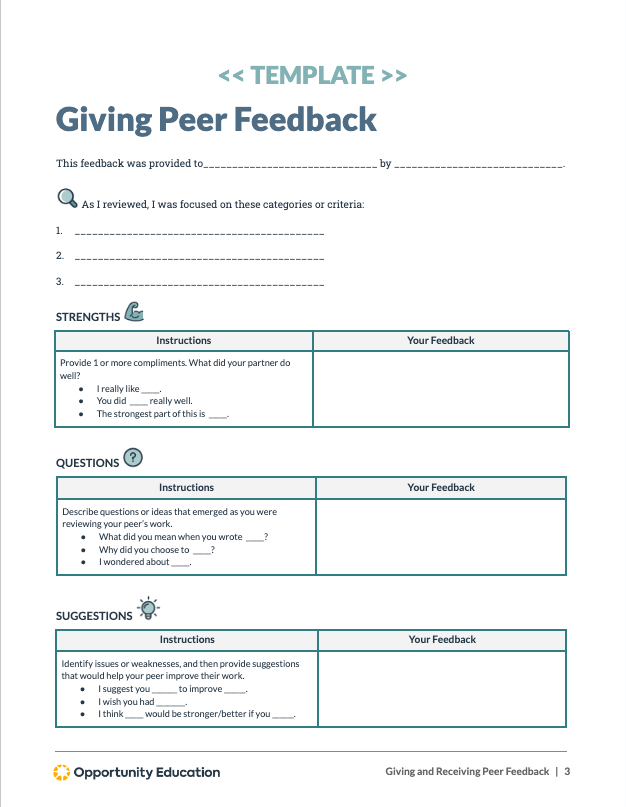
Templates and Examples
Giving and Receiving Peer Feedback
Customize two templates: one that supports students as they provide effective feedback to their peers, and one that supports students as they receive feedback effectively in order to learn and improve. Help them build their reflection and collaboration skills as they engage in meaningful peer feedback.
Related Resources

Templates and Examples
Peer Feedback Bingo
Facilitate the process of peer review and feedback through a game of bingo, and support student development of effective peer feedback skills.
Related Resources
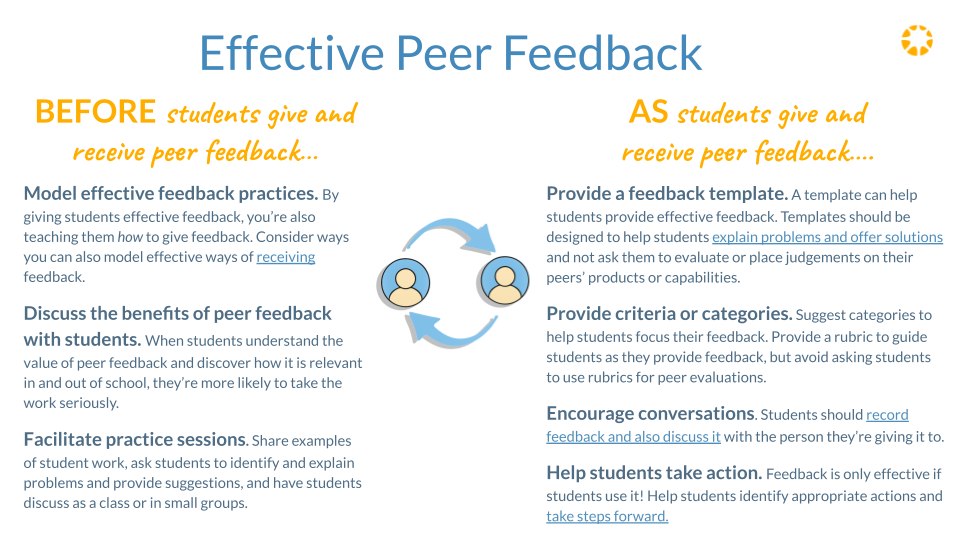
How-Tos and Overviews
Strategies for Effective Peer Feedback
Peer feedback exercises place students in the drivers seat of the feedback loop. But giving and receiving feedback is a skill students need to develop, through practice and with scaffolded support. Check out this infographic to get an overview of strategies and best practices, and take the first steps to support students as they develop this skills.
Related Resources

How-Tos and Overviews
Collaboration Checklist
Student collaboration is most successful when it is thoughtfully and intentionally incorporated into a learning experience. Essentially, work done in the group should be work that is *best done* with a group. Use this checklist to reflect on your plans and consider new reasons you might want to facilitate group work.
Related Resources
Templates and Examples
Playlists and Progress Trackers
This resource includes two templates that can be customized according to your goals for flexible pacing, parameters for student choice you have set, and the readiness of your students to self-pace or make choices about the paths of their learning. Use the playlist template to provide students with choices of activities, assignments, or learning stations as they progress through a series of topics, learning goals, or skill goals. Customize the progress tracker template, structured around the Must-do, Should-do, and Aspire-to-do lesson framework, and help your students track their progress through a series of milestones or learning goals.
Related Resources

Grab and Go Professional Learning
Backwards Planning and Lesson Classification
Effective flexible pacing begins with the end. In other words, it is only possible if you start by planning using backwards design: identifying what students will know and be able to do at the end of the parameters you set. Once you make those choices, you can then classify lessons and decide in advance which lessons are essential for achieving mastery and which are extensions that allow for students to deepen their understanding. Whether you want to provide flexibility within an entire course, an entire unit, or just a single concept, use these planning templates, inspired by Wiggins and McTighe's Understanding by Design and Modern Classroom Project's lesson classification framework, to set the foundation for effective implementation of flexible path and pacing.
Related Resources
Grab and Go Professional Learning
Choose (and Track!) Your Own Adventure
Lead a session for your colleagues that truly walks the talk: facilitate an exploration of playlists, progress trackers, and choice boards using a choice board that lets them make decisions about their professional learning based on their professional goals. Walk away with a solid understanding of the purpose, implementation, and benefits of these flexible pacing and specific, actionable plans to use one or more of these tools in the classroom.
Related Resources

Templates and Examples
Reading Circles
In reading circles, students have the opportunity to practice reading, writing, listening and speaking. The project parameters encourage students to practice several important skills, in addition to showing mastery of your content area. Students conduct close reading and interpretation of a choice text, collaborate with peers in purposeful group roles, and reflect and take a position on the text’s meaning, structure, and purpose. This project provides several opportunities for student choice. The templates for the student-facing materials are heavily scaffolded to support students who are still developing readers.
Related Resources

Templates and Examples
Hexagonal Thinking Project
During a hexagonal thinking discussion, students move around hexagons labeled with concepts or terms, making connections and building a web from the identified patterns. Webs evolve while students move, add, or remove tiles, reflecting on the connections they've identified and assessing one another’s arguments. This project builder leads you through the process of developing a hexagonal thinking project for your students, one that works in any classroom, with any subject area. Review the example for inspiration and customize the templates for your content, learning goals, and skill focus.
Related Resources

How-Tos and Overviews
5 Steps to Designing Your Space
Setting up your classroom is fun, but is it done with engagement in mind? Use this overview and accompanying infographic to shift the focus from "pretty" to "purposeful" when designing your space.
Related Resources

Templates and Examples
Scaffolding Socrates
During a Socratic seminar, students ask questions and challenge one another, respectfully debate perspectives, and drive the discussion themselves (instead of the teacher). Use this resource, including a project development guide, templates, and example, to plan and support successful student engagement in a Socratic seminar.
Related Resources

Templates and Examples
Dear Carbon, I Love You
This project prioritizes your students' creative energy as they demonstrate deep understanding of a key concept in your subject area - whether it's an organelle, an element, the quadratic formula, or topographic maps. Use the project template, example, and step-by-step instructions to create a summative love letter project and watch your students practice effective and persuasive composition, all in the name of love.
Related Resources

Templates and Examples
Give One, Get One
This Give One, Get One discussion strategy can be incorporated in a variety of ways into your classroom. For example, you could use this structured collaboration to activate prior knowledge before you begin a unit as well as assess understanding at the end. No matter the context, students will be active learners and active listeners during this activity, while you listen, observe, and identify patterns in student thinking.
Related Resources

Grab and Go Lesson Plans
Matter and Energy in Ecosystems
In this lesson plan including a facilitation guide, slide deck, and activity templates, students compare and contrast food chains and food webs on their way to discovering how matter and energy move through ecosystems. Then they use their knowledge to design their own models of either a savannah or tropical forest.

Grab and Go Lesson Plans
Newtonian vs. Non-Newtonian Fluids
In this active learning lesson, which includes a facilitation guide, slide deck, and student activity sheets, students design their own oobleck investigations to discover the differences between Newtonian and non-Newtonian fluids.
Related Resources

Grab and Go Lesson Plans
How Much Did You Pay for That?
Customize this lesson plan to introduce students to the idea of "having credit" and how credit cards work for both the holder and the issuing bank. Students will also explore the benefits of having available credit and how credit card behavior affects a person's credit score and credit report.

Templates and Examples
Reinterpretation of Text
Use our project development guide, including templates and an example, to build a summative group project tailored to the learning and skill goals of your unit. With this project, students come together to re-interpret and re-imagine a text or historical event in a way that answers an essential question. Whether they re-tell the Magna Carta as a series of skits, or transform a chapter from a novel into a sonnet, students will take a position, defend that argument with a creative interpretation, and share the product of their collaboration with their classmates.
Related Resources

Grab and Go Lesson Plans
Around the Fire: Oral Storytelling
In this active learning lesson, students analyze the purpose of techniques used in oral storytelling and then create an original story that is meant to be read aloud, with a reflection. Implementation options include reading for a live audience or virtual sharing via live or recorded performance.

Grab and Go Lesson Plans
The Revolutionary World of World History
In this lesson plan with a facilitation guide, slide deck, and student activity sheets, students explore how world history is different from national histories by considering a historical event from multiple perspectives.

Grab and Go Lesson Plans
Unconscious Bias
In this lesson, students define and identify unconscious bias, then reflect on their own biases and assess how bias affects their lives.
Related Resources

Grab and Go Lesson Plans
Active Reading: The Glass Castle
In this active reading unit, students read The Glass Castle by Jeannette Walls and conduct close reading and practice annotation. They connect with characters in a memoir and analyze how they develop over the course of the text, as well as identify, understand, and analyze themes in a memoir.
Related Resources

Grab and Go Lesson Plans
Keep Calm and Focus On
This customizable facilitation guide, slide deck, and student activity will help you facilitate a lesson on what it means to focus. Equip students with strategies to concentrate on relevant information and tasks without getting easily distracted, shift tasks effectively, and take mental and physical breaks when needed and appropriate.
Related Resources

Grab and Go Lesson Plans
Make an Effort
Whether you call it grit, determination, or just trying hard, making an effort is a crucial skill for all students to develop. This skill means taking initiative, making your work your own, and working hard to achieve goals, so that you can create something you are proud of. This customizable facilitation guide, slide deck, and student template will lead your students through a lesson on what it really means to make your best effort.
Related Resources

Grab and Go Lesson Plans
Ready, Set, Document!
Documenting is an essential skill that helps students succeed well beyond their time in school, in many facets of life. Use this customizable facilitation guide, slide deck, and template to facilitate a lesson on effective note-taking to keep track of ideas and tools that can help them organize and remember ideas.

Grab and Go Lesson Plans
Prepare to Plan
Planning is an essential skill that helps students succeed well beyond their time in school, in many facets of life. Use this lesson to motivate and equip students to gain more independence in their life with planning tools and strategies, as well as an awareness of time management.
Related Resources

Grab and Go Professional Learning
Talk About It: Learning Skills Conversations
The best way to make skills the focus of learning is to incorporate them into the conversations you have with students - discuss what they mean, their importance, how to practice them, and student growth. This customizable facilitation guide, slide deck, and thought catcher will help you and your colleagues make Learning Skills part of the daily conversation in your classes. These resources are designed using our Learning Skills, but can be easily adapted to work with any set of skills.

How-Tos and Overviews
Learning Skills Bookmarks
The Learning Skills are one of the three categories of skills that we focus on at Opportunity Education. We believe these skills are necessary for doing well in school, but more importantly, for thriving in careers, relationships, and life in general. In particular, the Learning Skills help students become lifelong learners that think critically and take initiative. These skill bookmarks give an overview of the meaning of each Learning Skill, as well as prompting questions and relevant academic vocabulary. Use these as a reference tool for planning, so that you can translate the curriculum and standards you already have into a focus on building skills.
Related Resources
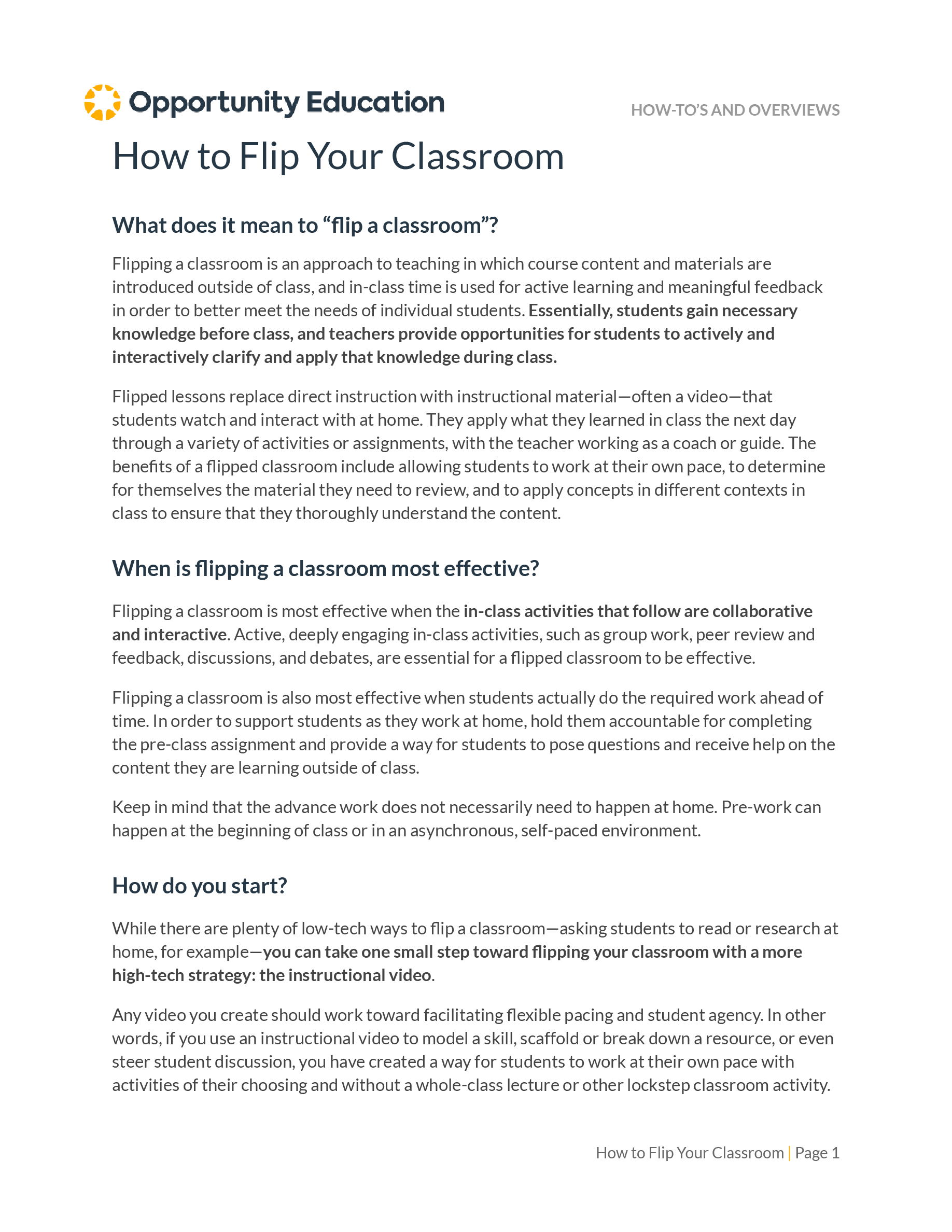
How-Tos and Overviews
How to Flip Your Classroom
Flipping your classroom doesn't mean you have to turn everything on its head. Take one small step toward blended learning with this overview: learn when and why you should flip a classroom activity and how you can make it happen with an instructional video.
Related Resources

How-Tos and Overviews
Learning Skills in Conversation
Helping students practice skills in your classroom isn’t just a matter of the planning and thinking that you do. Students need to know that they are practicing and mastering skills through the work they do. That means that skills need to be a part of your classroom conversations every day. Learn when, why, and how you can make skills the focus and part of every day's discussions with this one page overview.

How-Tos and Overviews
A Diagram of Differentiation
Differentiation doesn't have to be daunting! This diagram provides a quick, digestible overview of the four main ways to differentiate - through content, product, process, or learning environment - along with some tips for each type to help you get started.
Related Resources

How-Tos and Overviews
Inside. Outside. Changes. Engagement Inventory and Interventions
Engagement is more than participation. It is not about compliance or good behavior. Engaged learners prepare, focus, contribute, and invest in their learning. This resources provides a structure for taking stock of student engagement and a system for making changes.
Related Resources

How-Tos and Overviews
Active Learning Menu
Active Learning means learning by doing, working with others, solving problems, and making choices. This resource models one of those strategies, providing a choice board of methods for you to expand your practice, one “meal” at a time. Try out this menu and translate the concept of active learning into concrete strategies and actionable plans.

Grab and Go Professional Learning
Design Your Space
Physical spaces can have a big impact on student engagement and learning. You can design spaces that are more or less likely to encourage active learning, feedback and discussion, and the practice of skills. Work through this customizable professional learning session and explore how to create a space to support student learning and engagement, and then create it!

Grab and Go Professional Learning
Build Our Charter
Nobody really talks about the emotional lives of educators. Working at a school can be emotionally challenging. Think about it: in one hour, or even in a span of ten minutes, you could feel delight, despair, frustration, inadequacy, pride, and optimism. Join your colleagues to reflect on the emotions you want to feel at school, and ways to make feeling those emotions possible.
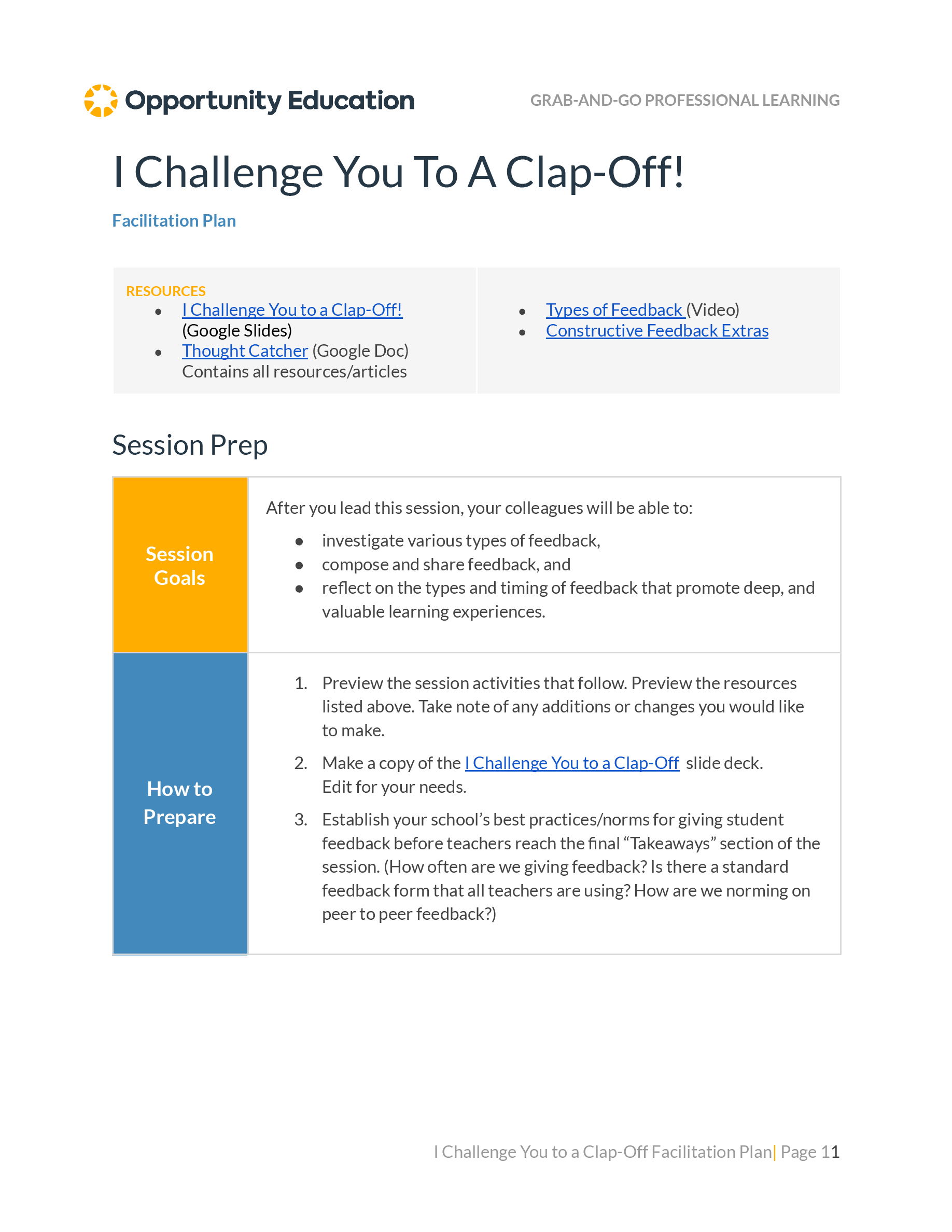
Grab and Go Professional Learning
I Challenge You To A Clap-Off!
Providing feedback is one of the most important aspects of a teacher's job, so it’s imperative that all feedback is intended to improve student learning and performance. Furthermore, feedback only works when students receive it, reflect on it, and take actions to improve. Work with your colleagues to learn more about this critical skill and practice effective techniques that will empower students to reflect and grow.

Grab and Go Professional Learning
Flip Your Classroom
Want to avoid lectures? Make self-pacing possible? Model skills, scaffold resources, and guides discussions? It's time to flip your classroom! Work through this session with your colleagues and learn how to make an instructional video that you can use to maximize active learning.
Related Resources

Grab and Go Professional Learning
Dare to Differentiate
One size doesn't fit all when it comes to the classroom, but a crucial part of increasing engagement with any group of students is thinking about differentiation. After you lead this session, you and your colleagues won't just be able to talk about differentiation, they will be ready to implement differentiation techniques in the classroom.
Related Resources

Grab and Go Professional Learning
Get On Your Feet
After you lead this session, participants will be able to understand what active learning actually is and how it benefits students and make a plan to create active and engaging learning experiences for students. The session facilitation guide includes links to Google slides and a customizable activity that you can make your own. Get your colleagues on their feet so they can walk away with active learning strategies on hand and real plans to implement them.
Related Resources

Templates and Examples
Roll the Dice: Collaboration
Asking students to work in groups is one thing. Teaching them how and giving them the tools to collaborate effectively is quite another. Don't roll the dice when it comes to group work success! Use this template and example to create a structure for collaboration in the classroom.
Related Resources

Templates and Examples
Make Groups Work
Getting students to work in groups can be hard. You’ve probably experienced it: your group of students is diverse, and everyone has different skills and knowledge and ways of communicating...great, right? Yes! But, sometimes when people come together with such different backgrounds, it can be hard to get everyone in agreement on how to approach the work that needs to be done. This resource includes three strategies for planning and facilitating structured group activities with your students: group work roles, rules, and sentence starters. Each strategy begins with an explanation and tips for implementation, followed by an editable template and options or examples.
Related Resources

Templates and Examples
Student Choice Board
This choice board template includes an example choice board that models how you can use it for stoichiometry practice problems.
Related Resources
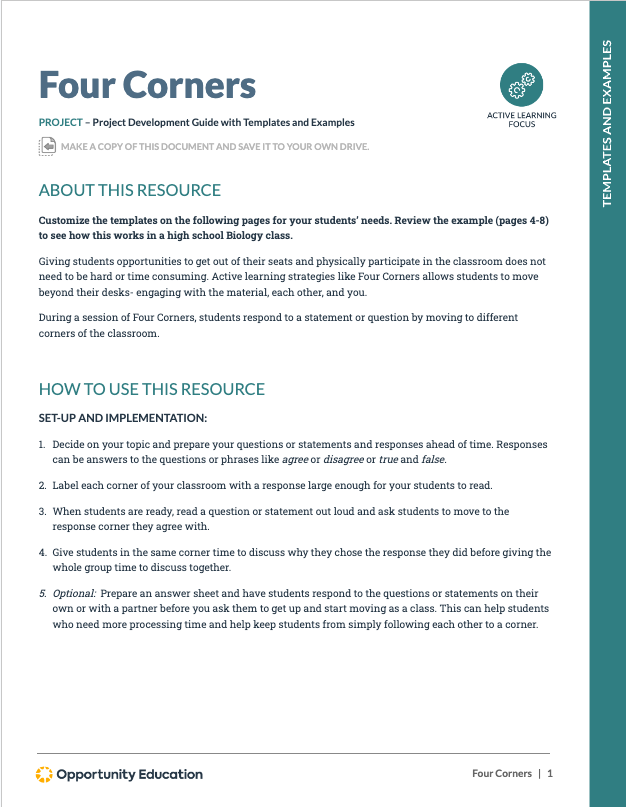
Templates and Examples
Four Corners
Giving students opportunities to get out of their seats and physically participate in the classroom does not need to be hard or time consuming. Active learning strategies like Four Corners allows students to move beyond their desks - engaging with the material, each other, and you. During a session of Four Corners, students are asked to respond to a statement or question by moving to different corners of the classroom. Customize the templates for your students’ needs and check out the example to see how this works in a high school Biology class.

Templates and Examples
Active Reading Bookmark
This Active Reading Bookmark prompts students to explore the text on their own, without a teacher telling them important concepts beforehand. It is a skill-building tool that supports students with comprehension and analysis as they read a text, giving them ownership over their understanding. Use the example bookmarks as inspiration, then customize the template to make it work for your students and materials!
Related Resources

Templates and Examples
Student Choice Menu
Serve up learning a la carte with a menu that provides students with choices and gives you opportunities for differentiation. Modify the template as you wish to create a menu of options for learning activities, formative assessments, or even project options. Grab some inspiration from two examples: the Blood and Cardiovascular System Menu and Romeo and Juliet: a Dinner to Die For.
Related Resources

Templates and Examples
Student Choice Tic-Tac-Toe
Give your students choice and differentiate their learning processes with a simple classroom activity that works for any grade and subject. This resource includes a customizable Tic-Tac-Toe template, as well as high school science and math examples that show both the teacher-facing and student-facing materials.